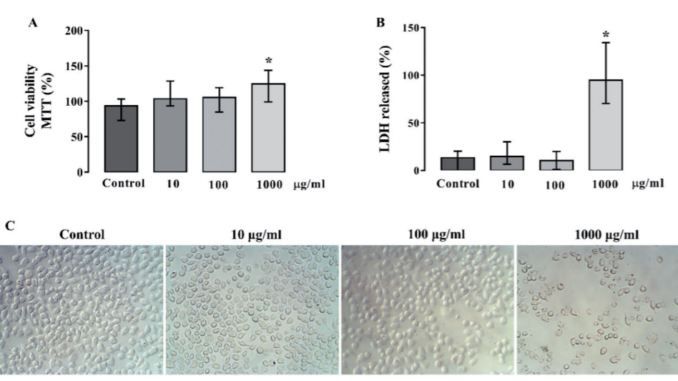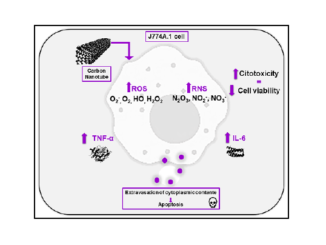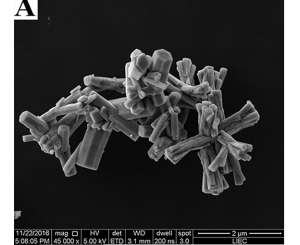
Analysis of cytotoxicity and genotoxicity in a short-term dependent manner induced by a new titanium dioxide nanoparticle in murine fibroblast cells
Abstract: The extensive use of titanium dioxide nanoparticles (TiO2 NPs) in cosmetics, food, personal care products, and industries brought concerns about their possible harmful effects. Nowadays it has become important to assess TiO2 NPs toxic effects as a way to understand their primary risks. In the cellular environment, after cell uptake, TiO2 NPs were described to induce reactive oxygen species (ROS) production, unbalance oxidative state, and activate apoptosis in several cell lines. Therefore, we aimed to evaluate the cytotoxicity and genotoxicity of a new TiO2 NP surface-functionalized with sodium carboxylic ligands in a murine fibroblast cell line (LA-9). TEM and DLS analyses were performed to define nanoparticle physicochemical characteristics. We evaluated the metabolic activity and LDH released after 24 h exposition to determine cytotoxic effects. Also, we evaluated DNA damage, intracellular reactive oxygen species (ROS) production, and apoptosis induction after 24 h exposure. The TiO2 NP impaired the cell membrane integrity at 1000 μg/mL, induced intracellular ROS production and late apoptosis at 24 h. The genotoxic effects were observed at all conditions tested at 24 h. Indeed, in fibroblasts exposed at 100 μg/mL was observed early apoptosis cells. The intracellular ROS content was increased in a dose-dependent manner. Thus, short-term exposure to TiO2 NP promoted cytotoxicity, genotoxicity and activated apoptosis pathways based on the potential role of oxygen species in the fibroblasts cell line.
Author(s): Matheus Pedrino, Patrícia Brassolatti, Ana Carolina Maragno Fattori, Jaqueline Bianchi, Joice Margareth de Almeida Rodolpho, Krissia Franco de Godoy, Marcelo Assis, Elson Longo, Karina Nogueira Zambone Pinto Rossi, Carlos Speglich &Fernanda de Freitas Anibal.
Toxicology Mechanisms and Methods
2021
DOI: https://doi.org/10.1080/15376516.2021.1994075
CDMF
The CDMF, hosted at the Federal University of São Carlos (UFSCar), is one of the Research, Innovation and Dissemination Centers (RIDC) supported by the São Paulo State Research Support Foundation (Fapesp), and also receives investment from the National Council Scientific and Technological Development (CNPq), from the National Institute of Science and Technology of Materials in Nanotechnology (INCTMN).




